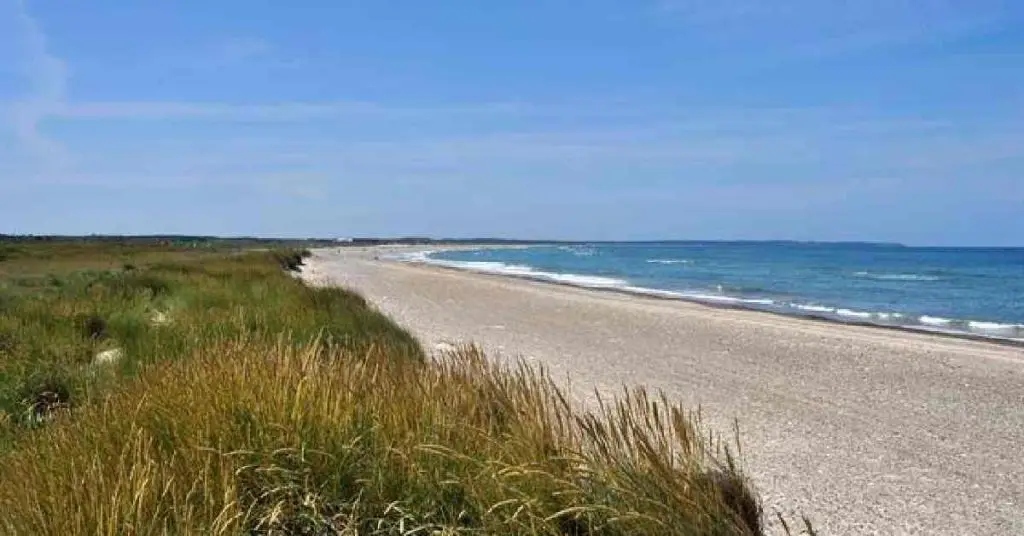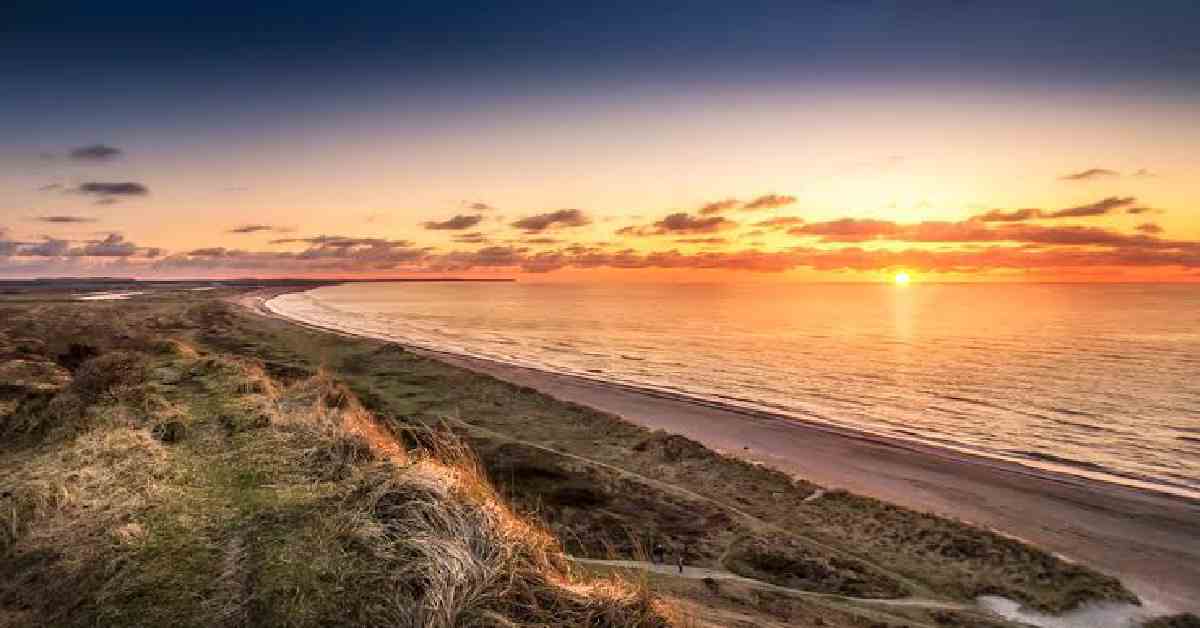Nestled along the northern coast of Denmark, Jammerbugten (translated as “The Bay of Wailing” in English) is a captivating place. Also, this scenic coastal area, stretching over 100 kilometers, is part of the remarkable North Jutland region. And it is renowned for its breathtaking landscapes, rich history, and thrilling outdoor activities. Additionally, during my visit to the bay, I could tell that Jammerbugten’s unique charm stems from its unspoiled beaches, rolling dunes, and dramatic cliffs.
A Short History of the Bay
The name Jammerbugten, with its somber connotations, finds its origins in the region’s treacherous maritime history. As the name suggests, “The Bay of Wailing,” it bears testament to the countless shipwrecks that have occurred off its shores. Known for its unpredictable weather and fierce storms, the waters around Jammerbugten have been a challenging passageway for sailors over the centuries.
The Geography of Jammerbugten
The landscape is dominated by wide stretches of sandy beaches, rugged cliffs, and impressive sand dunes. Thus, making it an inviting setting for nature lovers. One of its key attractions, Bulbjerg, is a dramatic limestone cliff rising 47 meters above sea level, offering stunning panoramic views of the surrounding coastline. Besides, this area is a haven for birdwatchers, as it is home to diverse bird species, including the rare northern fulmar.
The bay area is surrounded by rich heathlands and dense forests that harbor a variety of wildlife. The coastal region is also part of Thy National Park, Denmark’s first national park.
A Hub of Cultural Heritage
Beyond its natural allure, Jammerbugten holds deep cultural significance. The coastal towns and villages scattered along the bay are steeped in history. One of the most significant historical sites is the Svinkløv Badehotel, a charming seaside hotel renowned for its architecture and tranquil setting. Built in 1925, it stands as a testament to the region’s early tourism and cultural heritage.
Throughout the year, Jammerbugten hosts numerous cultural events and festivals that celebrate its history and traditions. From classic Danish music festivals to art exhibitions showcasing local talent, visitors have ample opportunities to immerse themselves.
A Destination for Adventure Seekers
For those seeking adventure, Jammerbugten offers an array of outdoor activities that make it a preferred destination for thrill-seekers. Its diverse landscapes are perfect for hiking, cycling, and horseback riding, while the waters of Jammerbugten are ideal for windsurfing, kiteboarding, and fishing. In addition, the area boasts over 120 kilometers of marked hiking trails. Hence, offering explorers varied routes that pass the scenic landscapes and overlook the stunning coastal views.
What’s more, the bay’s magnificent beaches, such as Blokhus and Løkken Strand, provide excellent conditions for sunbathing, swimming, and beach sports. These beaches are frequently dotted with colorful beach huts and are vibrant hubs of activity during the warmer months.
How and When to Visit Jammerbugten

Visiting Jammerbugten is an immersive experience that offers an extraordinary blend of nature, adventure, and culture. Whether you are drawn by its rugged beauty, its maritime history, or its charming villages, planning your trip to this stunning Danish bay requires some careful consideration to ensure you make the most of your visit. Here are some tips and insights to help guide your journey to Jammerbugten.
Best Time to Visit
The optimal time to visit Jammerbugten is during the late spring to early autumn months, from May to September. During this period, the weather is generally mild and pleasant, with temperatures averaging between 15°C and 22°C (59°F to 72°F). Furthermore, these months offer the best conditions for exploring the outdoor attractions and enjoying long, sunlit Scandinavian days. Summer, in particular, is ideal for beach activities and water sports, as the waters are warm and inviting.
Moreover, visiting outside of these months, such as in the late autumn or winter, has its own charm with less crowded attractions and a serene atmosphere. However, be prepared for cooler temperatures and shorter daylight hours.
Getting to Jammerbugten
Jammerbugten is easily accessible from various parts of Denmark. If you are flying into Denmark, the nearest major airport is Aalborg Airport. Besides, this is approximately 40 kilometers (about 25 miles) from the bay. From Aalborg, you can rent a car, which provides the most flexibility, or take advantage of the regional train and bus systems connecting to towns like Blokhus and Løkken.
What’s more, driving enables you to explore the broader North Jutland region at your own pace and make impromptu stops at scenic viewpoints and attractions. For those preferring public transport, trains and buses are available. Thereby, offering regular connections to the major towns along the bay.
Accommodations and Amenities
There is a wide range of accommodation options to suit various preferences and budgets. From cozy bed and breakfasts in villages to luxurious seaside resorts, there is something for everyone. A notable mention is the Svinkløv Badehotel, which provides a historic and charming setting directly on the coast.
Camping is also a popular choice, allowing visitors to truly connect with nature. There are several campgrounds providing facilities for tents, caravans, and motorhomes. At these sites, you can enjoy the fresh sea air and the serene surroundings while having easy access to the area’s natural attractions.
Conclusion
Jammerbugten beckons visitors with its combination of awe-inspiring landscapes, captivating cultural heritage, and vibrant outdoor activities. Also, this Danish bay, steeped in history and rich in natural diversity, stands as a testament to Denmark’s unique allure. From its troublesome maritime past to its commitment to sustainable tourism, this location captures the imagination. And it offers a hub for adventure and tranquility alike. Whether you are hiking the trails, exploring villages, or simply enjoying the windswept beaches, Jammerbugten promises an unforgettable journey.
Frequently Asked Questions about Jammerbugten
1. What is the historical significance of the name “Jammerbugten”?
Jammerbugten is translated as “The Bay of Wailing,” named due to the numerous shipwrecks and maritime casualties historically occurring in the area. This is with around 1,500 ships reportedly lost.
2. When is the best time to visit Jammerbugten?
The best time to visit is between May and September. This is when the weather is mild, and the conditions are ideal for outdoor activities and exploring the natural surroundings.
3. What are the main attractions to visit in Jammerbugten?
Key attractions include the dramatic limestone cliff Bulbjerg, the beautiful sandy beaches of Blokhus and Løkken Strand, and the cultural experiences.
4. How can I get to Jammerbugten from Copenhagen?
From Copenhagen, take a domestic flight to Aalborg Airport and then either rent a car for flexibility or use the regional train and bus services.
5. Are there accommodations available near Jammerbugten?
Yes, there is a wide range of accommodations. This includes seaside resorts like the Svinkløv Badehotel, cozy bed and breakfasts, and camping sites.
6. What activities are available for outdoor enthusiasts?
Jammerbugten offers hiking, cycling, horseback riding, water sports like windsurfing and kiteboarding, and opportunities for birdwatching and exploring.
7. Is it possible to visit Jammerbugten in winter?
Yes, visiting in winter offers a quieter, more peaceful experience. Although weather conditions will be cooler and daylight hours shorter, providing a different atmosphere by the coast.
8. What local cuisine can I try when visiting Jammerbugten?
Visitors can enjoy local delicacies such as fresh seafood, including fish and shellfish, often featured in traditional Danish dishes at restaurants in the coastal towns.
9. Are there any festivals or cultural events in Jammerbugten?
Yes, Jammerbugten hosts various events, such as music festivals and art exhibitions, especially in the summer months. Therefore, allowing visitors to enjoy the local culture and arts.




